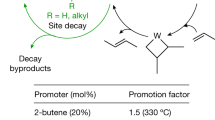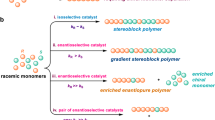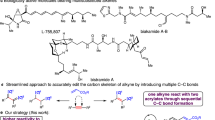Abstract
Olefin metathesis, as a powerful metal-catalysed carbon–carbon bond-forming method, has achieved considerable progress in recent years. However, the complexity originating from multicomponent interactions has long impeded a complete mechanistic understanding of olefin metathesis, which hampers further optimization of the reaction. Here, we clarify both productive and hidden degenerate pathways of ring-closing metathesis by focusing on one individual catalyst, using a sensitive single-molecule electrical detection platform. In addition to visualizing the full pathway, we found that the conventionally unwanted degenerate pathways have an unexpected constructive coupling effect on the productive pathway, and both types of pathway can be regulated by an external electric field. We then pushed forward this ability to ring-opening metathesis polymerization involving more interactive components. With single-monomer-insertion-event resolution, precise on-device synthesis of a single polymer was achieved by online manipulation of monomer insertion dynamics, intramolecular chain transfer, stereoregularity, degree of polymerization and block copolymerization. These results offer a comprehensive mechanistic understanding of olefin metathesis, exemplifying infinite opportunities for practical precise manufacturing.
This is a preview of subscription content, access via your institution
Access options
Access Nature and 54 other Nature Portfolio journals
Get Nature+, our best-value online-access subscription
$32.99 / 30 days
cancel any time
Subscribe to this journal
Receive 12 print issues and online access
$259.00 per year
only $21.58 per issue
Buy this article
- Purchase on SpringerLink
- Instant access to full article PDF
Prices may be subject to local taxes which are calculated during checkout





Similar content being viewed by others
Data availability
The data supporting the findings of this study are available within the paper and Supplementary Information. The datasets used in Supplementary Information are available online from the Zenodo repository at https://doi.org/10.5281/zenodo.13777604. Source data are provided with this paper.
References
Vougioukalakis, G. C. & Grubbs, R. H. Ruthenium-based heterocyclic carbene-coordinated olefin metathesis catalysts. Chem. Rev. 110, 1746–1787 (2010).
Trnka, T. M. & Grubbs, R. H. The development of L2X2RuCHR olefin metathesis catalysts: an organometallic success story. Acc. Chem. Res. 34, 18–29 (2001).
Montgomery, T. P., Ahmed, T. S. & Grubbs, R. H. Stereoretentive olefin metathesis: an avenue to kinetic selectivity. Angew. Chem. Int. Ed. 56, 11024–11036 (2017).
Fürstner, A. Olefin metathesis and beyond. Angew. Chem. Int. Ed. 39, 3012–3043 (2000).
Grubbs, R. H. & Chang, S. Recent advances in olefin metathesis and its application in organic synthesis. Tetrahedron 54, 4413–4450 (1998).
Nicolaou, K. C., Bulger, P. G. & Sarlah, D. Metathesis reactions in total synthesis. Angew. Chem. Int. Ed. 44, 4490–4527 (2005).
Ogba, O. M., Warner, N. C., O’Leary, D. J. & Grubbs, R. H. Recent advances in ruthenium-based olefin metathesis. Chem. Soc. Rev. 47, 4510–4544 (2018).
Becker, M. R., Watson, R. B. & Schindler, C. S. Beyond olefins: new metathesis directions for synthesis. Chem. Soc. Rev. 47, 7867–7881 (2018).
Hilf, S. & Kilbinger, A. F. M. Functional end groups for polymers prepared using ring-opening metathesis polymerization. Nat. Chem. 1, 537–546 (2009).
Mutlu, H., de Espinosa, L. M. & Meier, M. A. R. Acyclic diene metathesis: a versatile tool for the construction of defined polymer architectures. Chem. Soc. Rev. 40, 1404–1445 (2011).
Sinclair, F., Alkattan, M., Prunet, J. & Shaver, M. P. Olefin cross metathesis and ring-closing metathesis in polymer chemistry. Polym. Chem. 8, 3385–3398 (2017).
Ritter, T., Hejl, A., Wenzel, A. G., Funk, T. W. & Grubbs, R. H. A standard system of characterization for olefin metathesis catalysts. Organometallics 25, 5740–5745 (2006).
Lee, J. B., Ott, K. C. & Grubbs, R. H. Kinetics and stereochemistry of the titanacyclobutane–titanaethylene interconversion. Investigation of a degenerate olefin metathesis reaction. J. Am. Chem. Soc. 104, 7491–7496 (1982).
Tanaka, K., Tanaka, K., Takeo, H. & Matsumura, C. Intermediates for the degenerate and productive metathesis of propene elucidated by the metathesis reaction of (Z)-propene-1-d1. J. Am. Chem. Soc. 109, 2422–2425 (1987).
Stewart, I. C., Keitz, B. K., Kuhn, K. M., Thomas, R. M. & Grubbs, R. H. Nonproductive events in ring-closing metathesis using ruthenium catalysts. J. Am. Chem. Soc. 132, 8534–8535 (2010).
Easter, Q. T. & Blum, S. A. Single turnover at molecular polymerization catalysts reveals spatiotemporally resolved reactions. Angew. Chem. Int. Ed. 56, 13772–13775 (2017).
Easter, Q. T. & Blum, S. A. Evidence for dynamic chemical kinetics at individual molecular ruthenium catalysts. Angew. Chem. Int. Ed. 57, 1572–1575 (2018).
Easter, Q. T., Garcia, A. I. V. & Blum, S. A. Single-polymer–particle growth kinetics with molecular catalyst speciation and single-turnover imaging. ACS Catal. 9, 3375–3383 (2019).
Liu, C. et al. Single polymer growth dynamics. Science 358, 352–355 (2017).
Ibrahem, I., Yu, M., Schrock, R. R. & Hoveyda, A. H. Highly Z- and enantioselective ring-opening/cross-metathesis reactions catalyzed by stereogenic-at-Mo adamantylimido complexes. J. Am. Chem. Soc. 131, 3844–3845 (2009).
Flook, M. M., Jiang, A. J., Schrock, R. R., Müller, P. & Hoveyda, A. H. Z-selective olefin metathesis processes catalyzed by a molybdenum hexaisopropylterphenoxide monopyrrolide complex. J. Am. Chem. Soc. 131, 7962–7963 (2009).
Jiang, A. J., Zhao, Y., Schrock, R. R. & Hoveyda, A. H. Highly Z-selective metathesis homocoupling of terminal olefins. J. Am. Chem. Soc. 131, 16630–16631 (2009).
Koh, M. J., Nguyen, T. T., Zhang, H., Schrock, R. R. & Hoveyda, A. H. Direct synthesis of Z-alkenyl halides through catalytic cross-metathesis. Nature 531, 459–465 (2016).
Koh, M. J. et al. Molybdenum chloride catalysts for Z-selective olefin metathesis reactions. Nature 542, 80–85 (2017).
Torker, S., Müller, A. & Chen, P. Building stereoselectivity into a chemoselective ring-opening metathesis polymerization catalyst for alternating copolymerization. Angew. Chem. Int. Ed. 49, 3762–3766 (2010).
Endo, K. & Grubbs, R. H. Chelated ruthenium catalysts for Z-selective olefin metathesis. J. Am. Chem. Soc. 133, 8525–8527 (2011).
Keitz, B. K., Endo, K., Herbert, M. B. & Grubbs, R. H. Z-selective homodimerization of terminal olefins with a ruthenium metathesis catalyst. J. Am. Chem. Soc. 133, 9686–9688 (2011).
Khan, R. K. M., Torker, S. & Hoveyda, A. H. Readily accessible and easily modifiable Ru-based catalysts for efficient and Z-selective ring-opening metathesis polymerization and ring-opening/cross-metathesis. J. Am. Chem. Soc. 135, 10258–10261 (2013).
Khan, R. K. M., Torker, S. & Hoveyda, A. H. Reactivity and selectivity differences between catecholate and catechothiolate Ru complexes. Implications regarding design of stereoselective olefin metathesis catalysts. J. Am. Chem. Soc. 136, 14337–14340 (2014).
Yang, C. et al. Unveiling the full reaction path of the Suzuki–Miyaura cross-coupling in a single-molecule junction. Nat. Nanotechnol. 16, 1214–1223 (2021).
Zhang, A. et al. Catalytic cycle of formate dehydrogenase captured by single-molecule conductance. Nat. Catal. 6, 266–275 (2023).
Yang, C. et al. Single-molecule electrical spectroscopy of organocatalysis. Matter 4, 2874–2885 (2021).
Yang, C. et al. Real-time monitoring of reaction stereochemistry through single-molecule observations of chirality-induced spin selectivity. Nat. Chem. 15, 972–979 (2023).
Zhang, L. et al. Electrochemical and electrostatic cleavage of alkoxyamines. J. Am. Chem. Soc. 140, 766–774 (2018).
Yang, C. et al. Electric field-catalyzed single-molecule Diels–Alder reaction dynamics. Sci. Adv. 7, eabf0689 (2021).
Guan, J. et al. Direct single-molecule dynamic detection of chemical reactions. Sci. Adv. 4, eaar2177 (2018).
Guo, Y., Yang, C., Zhang, L. & Guo, X. Tunable interferometric effects between single-molecule Suzuki–Miyaura cross-couplings. J. Am. Chem. Soc. 145, 6577–6584 (2023).
Guo, Y., Yang, C., Zhou, S., Liu, Z. & Guo, X. A single-molecule memristor based on an electric-field-driven dynamical structure reconfiguration. Adv. Mater. 34, 2204827 (2022).
Chen, H. et al. Reactions in single-molecule junctions. Nat. Rev. Mater. 8, 165–185 (2023).
Dief, E. M., Low, P. J., Díez-Pérez, I. & Darwish, N. Advances in single-molecule junctions as tools for chemical and biochemical analysis. Nat. Chem. 15, 600–614 (2023).
Yang, C., Yang, C., Guo, Y., Feng, J. & Guo, X. Graphene–molecule–graphene single-molecule junctions to detect electronic reactions at the molecular scale. Nat. Protoc. 18, 1958–1978 (2023).
Deiters, A. & Martin, S. F. Synthesis of oxygen- and nitrogen-containing heterocycles by ring-closing metathesis. Chem. Rev. 104, 2199–2238 (2004).
Anderson, P. W. More is different. Science 177, 393–396 (1972).
Strogatz, S. et al. Fifty years of ‘More is different’. Nat. Rev. Phys. 4, 508–510 (2022).
Shaik, S., Ramanan, R., Danovich, D. & Mandal, D. Structure and reactivity/selectivity control by oriented-external electric fields. Chem. Soc. Rev. 47, 5125–5145 (2018).
Shaik, S., Danovich, D., Joy, J., Wang, Z. & Stuyver, T. Electric-field mediated chemistry: uncovering and exploiting the potential of (oriented) electric fields to exert chemical catalysis and reaction control. J. Am. Chem. Soc. 142, 12551–12562 (2020).
Shaik, S., Mandal, D. & Ramanan, R. Oriented electric fields as future smart reagents in chemistry. Nat. Chem. 8, 1091–1098 (2016).
Dief, E. M. & Darwish, N. SARS-CoV-2 spike proteins react with Au and Si, are electrically conductive and denature at 3 × 108 V m−1: a surface bonding and a single-protein circuit study. Chem. Sci. 14, 3428–3440 (2023).
Aragonès, A. C. et al. Electrostatic catalysis of a Diels–Alder reaction. Nature 531, 88–91 (2016).
Monfette, S. & Fogg, D. E. Equilibrium ring-closing metathesis. Chem. Rev. 109, 3783–3816 (2009).
Frisch, M. J. et al. Gaussian 09 (Gaussian, 2013).
Stephens, P. J., Devlin, F. J., Chabalowski, C. F. & Frisch, M. J. Ab initio calculation of vibrational absorption and circular dichroism spectra using density functional force fields. J. Phys. Chem. 98, 11623–11627 (1994).
Grimme, S., Ehrlich, S. & Goerigk, L. Effect of the damping function in dispersion corrected density functional theory. J. Comput. Chem. 32, 1456–1465 (2011).
Barone, V. & Cossi, M. Quantum calculation of molecular energies and energy gradients in solution by a conductor solvent model. J. Phys. Chem. A 102, 1995–2001 (1998).
Acknowledgements
We acknowledge primary financial support from the National Key R&D Program of China (2022YFE0128700 (to X.G.) and 2021YFA1200101 (to X.G.)), the National Natural Science Foundation of China (22150013 (to X.G.) and 21933001 (to X.G.)), the New Cornerstone Science Foundation through the XPLORER PRIZE (to X.G.), Beijing National Laboratory for Molecular Sciences (BNLMS-CXXM-202407 (to X.G.)), the Natural Science Foundation of Beijing (2222009 (to X.G.)), ‘Frontiers Science Centre for New Organic Matter’ at Nankai University (63181206 (to X.G.)), the Taishan Scholars Program of Shandong Province (tsqn202211012 (to Y.L.)), the China National Postdoctoral Program for Innovative Talents (BX20220014 (to C.Y.)), the National Natural Science Foundation of China (22303003 (to C.Y.)), the General Project of China Postdoctoral Science Foundation (2023M730049 (to C.Y.)), the China National Postdoctoral Program for Innovative Talents (BX20230024 (to Y.G.)) and the General Project of China Postdoctoral Science Foundation (2023M740065 (to Y.G.)).
Author information
Authors and Affiliations
Contributions
X.G., Y.G. and C.Y. conceived and designed the experiments. Y.G. and C.Y. fabricated the devices and performed the device measurements. L.Z. and F.M. carried out the molecular synthesis. Y.L., Y.H., X.L. and J.H. built and analysed the computational model and performed the quantum transport calculation. X.G., F.M., Y.G., C.Y., Y.Y., K.N.H., Y.X. and C.J. analysed the data and wrote the paper. All the authors discussed the results and commented on the paper.
Corresponding authors
Ethics declarations
Competing interests
The authors declare no competing interests.
Peer review
Peer review information
Nature Nanotechnology thanks Nadim Darwish and Bingqian Xu for their contribution to the peer review of this work.
Additional information
Publisher’s note Springer Nature remains neutral with regard to jurisdictional claims in published maps and institutional affiliations.
Extended data
Extended Data Fig. 1 Simulated potential energy profiles of different pathways in RCM.
Gibbs free energies (kcal/mol) and intermediate structures are given in the figure. Computational studies were performed with B3LYP-D3/def2TZVPP//B3LYP/ def2SVP(Ru) 6-31G(d,p)(C H O N Cl). Solvent = toluene; T = 298 K. a. Potential energy profile of the productive pathway. b. Potential energy profile of the degenerate pathway (a). c. Potential energy profile of the degenerate pathway (b). d. Potential energy profile of the degenerate pathway (c). Abbreviations: RS, reactant state; TS, transition state; IM, intermediate; PS, productive state; D, degenerate; a, metathesis pathway (a); b, metathesis pathway (b); c, metathesis pathway (c); t, trans; c, cis. RS = complex 1 + substrate; IM1 = complex 2; IM2 = complex 3; IM3 = complex 4; PS = complex 1 + product; D-a-IM = complex 5; D-b-IM-t = complex 6; D-b-IM-c = complex 7; PS-t = complex 1 + trans-product; PS-c = complex 1 + cis-product.
Extended Data Fig. 2 Statistical dynamic information of ROMP.
a. Dwell time of Ru-based alkylidene (solid line) and metallacyclobutane (dash line) in bias voltage-dependent measurements of ROMP using COE (blue line) and NBE (green line). Abbreviations: alk = alkylidene; mcb = metallacyclobutane. The error scales were derived from the statistics of three different devices (n = 3). Data are presented as mean ± s.d. τmcb was longer than τalk in the polymerization of COE (for example, at VSD = 0.1 V and COE concentration = \(1\times {10}^{-4}\) mol L−1, τmcb = 3202.6 ± 182.5 ms, τalk = 906.5 ± 10.4 ms), indicating that the ring-opening process of metallacyclobutane is the rate-determining step (RDS). As for NBE, the RDS is the formation of metallacyclobutane (for example, at VSD = 0.1 V and NBE concentration = \(1\times {10}^{-4}\) mol L−1, τmcb = 146.8 ± 3.8 ms, τalk = 468.0 ± 5.2 ms), which is consistent with the high ring strain energy of NBE. b. Polymerization rates in bias voltage-dependent measurements of ROMP using COE (blue bar) and NBE (green bar), demonstrating the high activity of NBE as the monomer in ROMP. The error scales were derived from the statistics of three different devices (n = 3). Data are presented as mean ± s.d.
Extended Data Fig. 3 Statistics of recorded photons of the polymer chain with different numbers of f-COE.
a. Schematic of the polymer chain with the segment sequence of COE(n = 20) → f-COE(n = 1) → COE(n = 20) → f-COE(n = 1) → …. b. For 20 different devices, recorded photon numbers of the polymer chain with different numbers of f-COE (1−4). For each device, the error scales were derived from the statistics of 3 independent tests (n = 3). Data are presented as mean ± s.d.
Supplementary information
Supplementary Information
Supplementary Figs. 1–49, Discussion, Schemes 1 and 2 and Table 1.
Supplementary Video 1
Real-time optical monitoring of the trajectory of the polymer chain terminus (that is, the fluorescent polystyrene bead) in the polymerization process. A 405 nm, 5 mW laser was focused on the graphene device through a ×100 oil lens and 5,000 photos taken with an exposure time of 50 ms. The bright pixels refer to the real-time location of the fluorescent polystyrene bead.
Source data
Source Data Fig. 2
Statistical source data for Fig. 2.
Source Data Fig. 3
Statistical source data for Fig. 3.
Source Data Fig. 4
Statistical source data for Fig. 4.
Source Data Fig. 5
Statistical source data for Fig. 5.
Source Data Extended Data Fig. 2
Statistical source data for Extended Data Fig. 2.
Source Data Extended Data Fig. 3
Statistical source data for Extended Data Fig. 3.
Rights and permissions
Springer Nature or its licensor (e.g. a society or other partner) holds exclusive rights to this article under a publishing agreement with the author(s) or other rightsholder(s); author self-archiving of the accepted manuscript version of this article is solely governed by the terms of such publishing agreement and applicable law.
About this article
Cite this article
Guo, Y., Yang, C., Zhang, L. et al. Full on-device manipulation of olefin metathesis for precise manufacturing. Nat. Nanotechnol. 20, 246–254 (2025). https://doi.org/10.1038/s41565-024-01814-y
Received:
Accepted:
Published:
Issue date:
DOI: https://doi.org/10.1038/s41565-024-01814-y
This article is cited by
-
On-device programmable synthesis of polymers
Science China Materials (2025)



